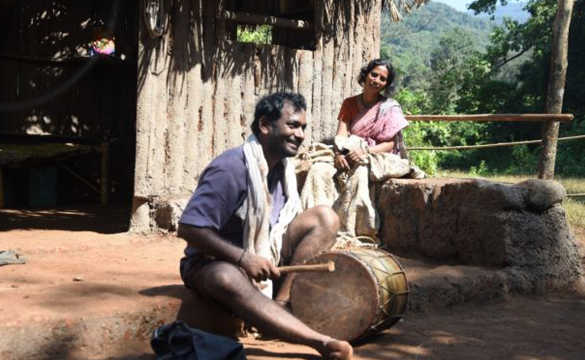
Keyur Seta
Mumbai, 05 Mar 2020 7:30 IST
Bitter Tree is not just about the technical prowess of the team. The film also scores highly in storytelling and performances.

Almost three years ago, cinematographer Sameer Bhaskar achieved the rare feat of shooting an entire film of 83 minutes in a single take. That film was the Konkani project Mahaprayan. Now comes his second such work, Kaajro (Bitter Tree), also in Konkani and also shot in a single take.
At just under two hours, Kaajro is longer than Mahaprayan. Directed by Nitin Bhaskar, the film is based on a story by Dr Prakash Paryienkar.
The film takes place in a little village in the Konkan. Tilgya (Vitthal Kale), a poor man from a so-called lower caste, stays with wife Gokulya (Jyoti Bagkar) in a village that is largely occupied by so-called high-caste people. Tilgya and Gokulya eke out a hand-to-mouth existence by doing odd jobs. Gokulya has been very sick the past six months, which has made life tougher than ever for Tilgya. But he is ready to do anything to save her.
Kaajro is the story of Tilgya and Gokulya's two-hour ordeal on the day of the festival, Dussehra. Tilgya has run from pillar to post to try and get his wife cured. From a general physician to an ayurvedic expert to an occult specialist, he has tried them all.
On the day, he plays the drums for the villagers for a Dussehra puja. Yet, he also faces discrimination because of his caste. Then he hears a shattering piece of news, and Tilgya is forced to undertake a tough journey on a day that is considered auspicious by Hindus.
The story requires Tilgya’s character to move constantly from places like his hut to the nearby temple and a few houses in the village. The roads are sloping and bumpy at times, which would have made it tough for the cinematographer as well.
But Bhaskar’s biggest challenge was to shoot a scene in which two men are walking towards a bike. They set off on the vehicle and their entire journey is also shot in a single take from the front.
Shooting a film in one take is not an ordeal only for the technical team. One should not forget that the artistes also can’t afford to slip up anywhere, like in theatre. But Kale and Bagkar's task was tougher than one can imagine. This is because apart from great acting ability, they had to show immense physical strength.
For a large portion of the film, Tilgya carries Golulya on his back and travels from his house to the main road and then across a river. One can only imagine the kind of pains they went through while filming the scene and rehearsing it for days before the shooting. Although Bagkar had to play a corpse, that is not as easy as it sounds when you are being carried on someone's back.
But Kaajro is not just about the incredible efforts of the director, cinematographer and artistes to shoot it in a single take. While Mahaprayan lagged behind in some areas of storytelling, this film has hard-hitting, no-holds-barred content that is narrated intelligently and with impact.
The film takes a strong stand against casteism with the use of just visuals and situations. There are moments when you are sickened by the behaviour of the elite towards Tilgya. For example, the village head and other people taking part in the puja can’t do without Tilgya’s music. But after the ritual, he can’t even cross their path as that is considered ‘inauspicious’. Of course, that is not the only indignity he faces.
Tilgya’s remark sums up the film poignantly and succinctly, when he says the forest never discriminates among the different tree species living in it, only humans do.
Kaajro was screened at the MAMI Mumbai Film Festival on 22 October 2019 and at the Bengaluru International Film Festival on 2 March 2020.

